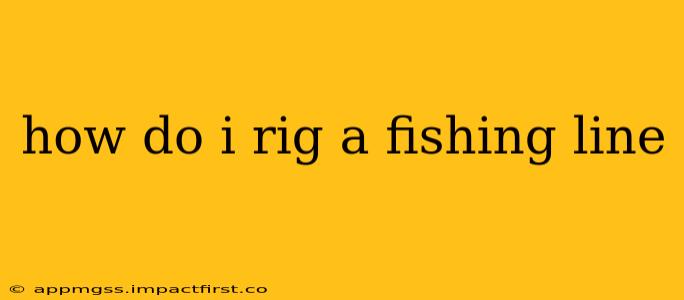How to Rig a Fishing Line: A Comprehensive Guide for Anglers of All Levels
Rigging your fishing line correctly is crucial for success. It directly impacts your ability to present your bait or lure effectively, enticing fish to bite. This guide covers various rigging techniques, catering to different fishing styles and target species. Whether you're a seasoned angler or just starting, you'll find valuable information here.
What is a Fishing Rig?
A fishing rig is the assembly of your fishing line, hooks, weights, and any other components necessary to present your bait or lure attractively to the fish. The right rig can significantly increase your chances of landing a fish. The type of rig you choose depends heavily on factors like the type of fish you're targeting, the water conditions, and the type of bait or lure you're using.
Basic Fishing Rig Components:
Before diving into specific rigs, let's cover the essential components:
- Fishing Line: The backbone of your rig. Choose the right line strength and type based on your target fish and fishing conditions.
- Hooks: Used to secure your bait or lure and hook the fish. Hook size and style vary depending on the bait and target species.
- Weights (Sinkers): Used to get your bait or lure down to the desired depth, especially in deeper water or when fishing in current. Various weights and styles exist, including split shot, bullet weights, and egg sinkers.
- Swivels: Prevent line twist, especially important when using lures that spin or when fishing with heavier weights.
- Bobbers (Floats): Keep your bait or lure suspended at a specific depth. Useful for fishing near the surface.
- Leaders: A shorter length of stronger line tied to your main line, particularly useful when fishing for fish with sharp teeth or around abrasive structures.
Different Types of Fishing Rigs:
Here are some common and effective fishing rigs:
1. Simple Hook Rig: This is the most basic rig, consisting of your main line and a hook. Ideal for simple fishing situations with light tackle.
2. Carolina Rig: A popular bass fishing rig that features a weight on the main line, above a swivel, then a leader with a hook. Excellent for covering a lot of water and keeping your bait off the bottom.
3. Texas Rig: Another popular bass fishing rig using a bullet weight and a hook with a plastic worm or creature bait. The weight is pegged to the line, preventing snags.
4. Drop Shot Rig: A versatile technique, especially effective in clear water, where a weight is tied to the main line, and a hook is tied above it on a separate leader. This allows for precise bait presentation at various depths.
5. Palomar Knot: A reliable knot for tying your line to the hook. It creates a strong and compact connection.
6. Improved Clinch Knot: Another dependable knot widely used for its strength and simplicity.
How to Choose the Right Rig:
The best rig depends on several factors:
- Target Species: Different fish require different rigs.
- Water Conditions: Current, depth, and clarity affect rig selection.
- Bait or Lure: Some rigs are more suitable for certain baits or lures.
- Fishing Location: Structure, vegetation, and bottom type influence rig choice.
Experimentation is key to finding what works best in various situations.
Frequently Asked Questions (FAQs)
How do I tie a fishing knot? Numerous knots exist, each with its strengths and weaknesses. Popular options include the Palomar knot, Improved Clinch knot, and Albright knot. Online tutorials and books offer detailed instructions.
What kind of line should I use for fishing? The best fishing line depends on your target species and fishing conditions. Monofilament, fluorocarbon, and braided lines each have their advantages and disadvantages.
How do I choose the right hook size? Hook size corresponds to the size of your bait or lure and the target fish. Larger hooks for larger fish, and smaller hooks for smaller fish and smaller baits.
What is the best weight for fishing? This depends on the water depth, current speed, and the type of bait you’re using. Start with a weight that allows your bait to reach the desired depth and adjust as needed.
Can I make my own fishing rigs? Absolutely! Making your own rigs allows you to customize them to your specific needs and preferences. It can be a fun and cost-effective way to enhance your fishing experience.
This guide provides a foundation for understanding fishing rigs. Continued practice and experimentation will refine your skills and lead to greater success on the water. Remember to always respect the environment and practice catch and release when appropriate.
